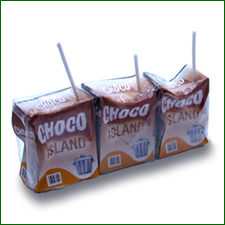
Tetrapaks are almost universal over the whole planet. And, up 'til now, they have been very difficult to recycle. Each is made of a sandwich, printed plastic on the outside of a layer of white paper and aluminum foil on the inside. The aluminum seems to have a coating too. These three layers are very hard to separate.
I have seen people, on the web, who run these cartons through a shredder, then subject the result to strong agitation in water. This pulps out about 90% of the paper layer, leaving the plastic and Al foil layers. Then spread this out on a form made from a corrugated sheet, dry it and apply heat to semi melt the plastic, thus making a roofing sheet. Nice!
I thought of saving energy by:
1) Putting the shredded and partly pulped cartons into a simple batch biodigester with a source of enough fixed nitrogen, etc. to support digestion of the paper pulp. This is not to produce methane, altho it might make a little. This also takes care of any food residue in the cartons.

2) When the new sheet is dried on the form, remove it and set the plastic using a large fresnel lens to heat it.
I think these roofs would tend to shed some foil over the years but still would be worthwhile.
Roy 20:02, 8 May 2006 (PDT)
Instead of shredding the tetrapacks and destroying all their desirable properties like water-tightness and insulation, why not just flatten the cartons and nail them to a roof like shingles? Fenn 20:31, 11 March 2009 (UTC)
Having tried using tetrapak outdoors myself (for plant pots one year) you will find that the exposed paper (nail holes, cut edges) will soak up water, causing it to swell around the edges, letting in more water. Once it gets soft, the nails or staples that you use will not hold the softened sheet in the wind as it gets floppy and weak. The thin plastic also degrades fairly quickly in the sun and tends to break down, again losing its waterproof qualities.
If you can get them, Aluminium cans make much better flashing (but not great roofing). PET bottles would last longer than raw tetrapak carton, but they break down in the UV light from the sun too, tending to delaminate and get bubbles inside them or peel away in flakes. PET with a living roof over it could work, as the soil would protect the PET from sunlight and the PET would protect the building from water. JohnGH (talk) 22:39, 15 October 2020 (UTC)
Click on the Discussion tab at the top of the page to open an area for discussion. Then just type and save the page.